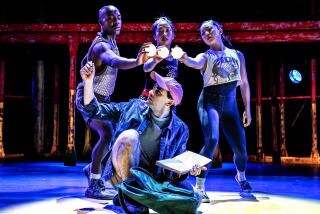DANCE REVIEW : ‘Life’ Beyond Solidarity
- Share via
As the cultural arm of the once-outlawed Solidarity union, Akademia Ruchu is a movement-theater ensemble with every reason to celebrate Poland’s new freedoms.
Instead, in its first visit to the United States, this 19-year-old institution has mounted a bitter study of the spiritual vacuum that can follow violent change, “Everyday Life After the Great Revolution, Two.”
Like the early post-modernists of American dance, this eight-member company shapes commonplace, often task-oriented motion into imaginative theatrical haiku. In its American premiere Friday at LACE, “Everyday Life” offered potent vignettes on rootless individualism, meaningless labor, bureaucratic miscommunication and a growing desperation about the society’s loss of shared values.
Literally framing these sequences: four free-standing metal window units, each holding six glass panes.
Initially placed directly behind one another, like curtains, the units divided the stage into narrow slices that served alternately as rooms, corridors and streets. Moreover, by making the audience look through these windows, director Wojciech Krukowski defined us as voyeurs: outsiders peeking in.
In the first sequence, five people carried distinctive props--everything from a scrub brush to a sex toy--that they kept exchanging during restless hop-and-run cycles that took them from corridor to corridor.
Next, we saw the equivalent of a time-lapse film on urban decay: company members papering over the windows, tearing the paper, adding bits of photographs and slogans, then painting red slashes across each collage--and eventually washing everything clean again.
Tabletops inserted between window units turned the corridors into offices where a Tower of Babel sequence ensued: phones incessantly ringing, workers obsessed with keeping their desks in order.
The final, quasi-documentary picture of everyday life showed a line of numbed-out, trembling citizens collapsing and one of its members kicking his foot through one of the glass panes. Definitely a warning. However, two episodes took the piece beyond social portraiture into poetic abstraction--into memory and dream:
* The sound of rushing water accompanied the slow unrolling of a huge scroll--12 lines in the language of the Kashubes (a Slavic people living in the maritime area of Poland)--conveying traditional values through such words as family, truth, courage and loyalty.
* In a visionary epilogue, the members of Akademia Ruchu re-arranged the window frames so that only one big corridor remained--and, in a similar expansion of scale, those slashes of red paint seen earlier became a wide crimson carpet for this new pathway.
Moving through it--indeed, actually dancing through it, eyes closed--were the same five everyday people seen throughout the evening. Only now they clustered together, wrapped in a communal, crimson hoop-skirt that made them belong as much to the space they danced in as to one another.
Polish intellectuals will tell you the image was intended to be ironic, depicting a sentimental evasion. But at least one Yankee voyeur at LACE found it a statement of the deep need for wholeness and a linked destiny shaping Polish consciousness--why no mere revolution will ever be enough.
More to Read
The biggest entertainment stories
Get our big stories about Hollywood, film, television, music, arts, culture and more right in your inbox as soon as they publish.
You may occasionally receive promotional content from the Los Angeles Times.










